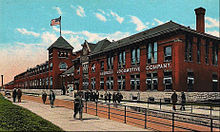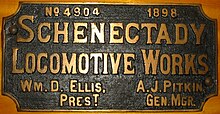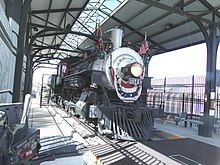
The American Locomotive Company was an American manufacturer of locomotives, diesel generators, steel, and tanks that operated from 1901 to 1969.

GE Transportation is a division of Wabtec. It was known as GE Rail and owned by General Electric until sold to Wabtec on February 25, 2019. The organization manufactures equipment for the railroad, marine, mining, drilling and energy generation industries. The company was founded in 1907. It is headquartered in Pittsburgh, Pennsylvania, while its main manufacturing facility is located in Erie, Pennsylvania. Locomotives are assembled at the Erie plant, while engine manufacturing takes place in Grove City, Pennsylvania. In May 2011, the company announced plans to build a second locomotive factory in Fort Worth, Texas, which opened in January 2013.

Montreal Locomotive Works (MLW) was a Canadian railway locomotive manufacturer which existed under several names from 1883 to 1985, producing both steam and diesel locomotives. For a number of years it was a subsidiary of the American Locomotive Company. MLW's headquarters and manufacturing facilities were in Montreal, Quebec.

The GE U25B is General Electric's first independent entry into the United States domestic road switcher diesel-electric locomotive railroad market for heavy production road locomotives since 1936. From 1940 through 1953, GE participated in a design, production, and marketing consortium (Alco-GE) for diesel-electric locomotives with the American Locomotive Company. In 1956 the GE Universal Series of diesel locomotives was founded for the export market. The U25B was the first attempt at the domestic market since its termination of the consortium agreement with Alco.
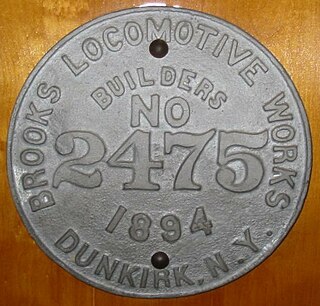
The Brooks Locomotive Works manufactured railroad steam locomotives and freight cars from 1869 through its merger into the American Locomotive Company (ALCO) in 1901.

H.K. Porter, Inc. (Porter) manufactured light-duty railroad locomotives in the US, starting in 1866. The company became the largest producer of industrial locomotives, and built almost eight thousand of them. The last locomotive was built in 1950, but the company continues to produce industrial equipment to this day.

The Cooke Locomotive and Machine Works, located in Paterson, New Jersey, manufactured steam railroad locomotives from 1852 until it was merged with seven other manufacturers to form American Locomotive Company (ALCO) in 1901.
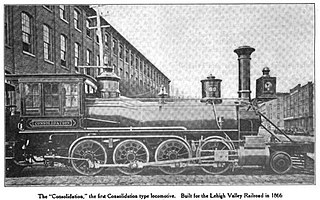
Under the Whyte notation for the classification of steam locomotives, 2-8-0 represents the wheel arrangement of two leading wheels on one axle, usually in a leading truck, eight powered and coupled driving wheels on four axles, and no trailing wheels. In the United States and elsewhere, this wheel arrangement is commonly known as a Consolidation, after the Lehigh and Mahanoy Railroad’s Consolidation, the name of the first 2-8-0.
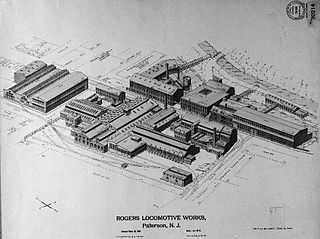
Rogers Locomotive and Machine Works was a manufacturer of railroad steam locomotives based in Paterson, in Passaic County, New Jersey, in the United States. Between its founding in 1832 and its acquisition in 1905, the company built more than 6,000 steam locomotives for railroads around the world. Most 19th-century U.S. railroads owned at least one Rogers-built locomotive. The company's most famous product was a locomotive named The General, built in December 1855, which was one of the principals of the Great Locomotive Chase of the American Civil War.

Dickson Manufacturing Company was an American manufacturer of boilers, blast furnaces and steam engines used in various industries but most known in railway steam locomotives. The company also designed and constructed steam powered mine cable hoists. It was founded in Scranton, Pennsylvania by Thomas Dickson in 1856. In total, the company produced 1,334 steam locomotives until it was taken over by ALCO in 1901.

Manchester Locomotive Works was a manufacturing company located in Manchester, New Hampshire, that built steam locomotives and fire engines in the 19th century. The first locomotive the company built was for the Chicago, Burlington and Quincy Railroad in March 1855.

Richmond Locomotive Works was a steam locomotive manufacturing firm located in Richmond, Virginia.

The Jupiter was a 4-4-0 steam locomotive owned by the Central Pacific Railroad. It made history when it joined the Union Pacific No. 119 at Promontory Summit, Utah, during the Golden Spike ceremony commemorating the completion of the First transcontinental railroad in 1869.

Union Pacific No. 119 was a 4-4-0 steam locomotive made famous for meeting the Central Pacific Railroad's Jupiter at Promontory Summit, Utah, during the Golden Spike ceremony commemorating the completion of the First transcontinental railroad in 1869. The locomotive was built by Rogers Locomotive and Machine Works of Paterson, New Jersey in 1868, along with numbers 116, 117, 118 and 120. The original was scrapped in 1903, but a replica now operates at the Golden Spike National Historical Park.
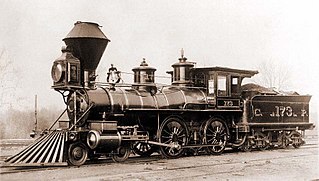
The Central Pacific Railroad number 173 was a 4-4-0 steam locomotive built by Norris-Lancaster for the Western Pacific Railroad in 1864. After its acquisition by Central Pacific, 173 was involved in a bad wreck, lying idle for two years before undergoing a sweeping reconstruction by the line's Sacramento Shops. It subsequently became the prototype for the railroad's engines when the CP began constructing locomotives. The engine was successful, and more engines were built to 173's design.

Maine Central 470 is a 4-6-2 "Pacific" type steam locomotive built by the American Locomotive Company (ALCO) in May 1924 for the Maine Central Railroad (MEC). Currently owned by the New England Steam Corporation, it is being restored to operating condition at Washington Junction in Hancock, Maine.

